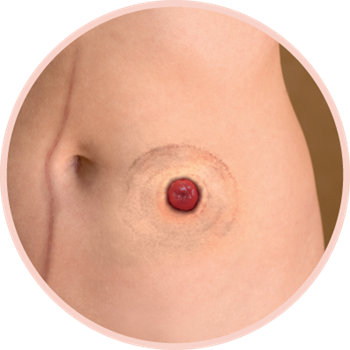 answers
answers
Why is it important to maintain healthy peristomal skin?
If the skin around your stoma (peristomal skin) becomes damaged, it could be painful and lead to infection. It also becomes more difficult for the skin barrier of your pouching system to adhere to your skin. Prevention is the key to maintaining both healthy peristomal skin and your comfort.

Know what healthy skin looks like
When you apply the skin barrier of your pouching system, it's important to make sure your peristomal skin is healthy and dry. This will ensure the pouch stays in place between changes.
Make note of how your peristomal skin looks when it's healthy. Peristomal skin should look similar to the skin on the other side of your abdomen: smooth and not irritated. Once you know what healthy skin looks like, you can watch for signs of skin irritation.
Common Causes of Peristomal Skin Damage
Leakage - Healthy skin exposed to fecal or urine output under the skin barrier can break down fast.
Pressure - Belts and some clothing may cause pressure on the stoma area.
Stoma size - Ensure the skin barrier is cut to the right size. It should always fit closely around the stoma (1-2 mm larger) to protect against leakage.
Skin folds or creases may prevent the skin barrier from sticking securely to the stomach and result in leakage. A different shaped product may be required if the stoma is flush or retracted.
Skin stripping or friction by removing a skin barrier too quickly can pull the top layers of skin away. The more frequent it happens, the more the skin can be irritated.
Pouching system - If the red or irritated area of the skin is the same shape as the skin barrier, you may have developed an allergy or sensitivity.
Prevention is a crucial part of a successful peristomal skin care regimen. You can help prevent peristomal skin issues with helpful skin care tips.
Tips for Peristomal Skin Care
- Change the pouch routinely.
- Gently remove the skin barrier from top to bottom – an adhesive remover may help.
- Clean the skin around the stoma with a wipe soaked in warm water.
- Use all-natural products. Make sure to use a soap that is oil and residue-free.
- Dry the skin thoroughly before applying the next bag.
- Inspect the skin with every skin barrier change.
- Apply a skin barrier foam or spray if needed.
As a general rule, healthy peristomal skin should look the same as skin anywhere else on the body. Often times, when the barrier is removed, the may notice some redness from the adhesive. This is normal. If the redness does not go away, however, it could be a sign of a peristomal skin issue. Discomfort is another sign that the peristomal skin is not healthy.
Healthy Skin
Irritated Skin
Proper fit of the skin barrier around the stoma is also important to prevent peristomal skin problems.
- For one-piece systems, a thin, flexible adhesives will protect your skin and allow for more frequent pouching system changes.
- For two-piece systems, special moldable skin barriers designed to hug the contours of your stoma and eliminate gaps provide a snug fit that may help minimize peristomal skin problems.
Contact the me+™ support team at 1-800-465-6302 to speak to one of our nurses and/or product specialists and request an ostomy system evaluation.
If you are living with an ostomy, chances are at some point, you might experience problems with peristomal skin or the skin around your stoma.
Call me+™ support at 1-800-465-6302, Mon-Fri, 8:00am to 6:00pm ET to order your free copy of A Clear Guide to Healthy Peristomal Skin.